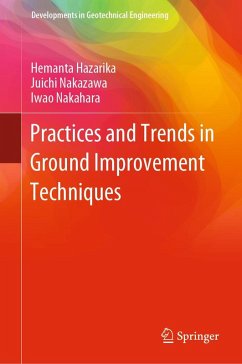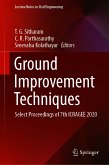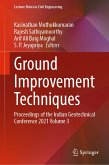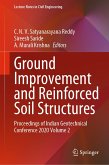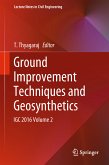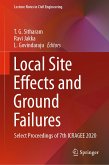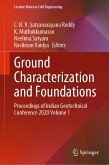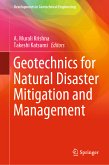Practices and Trends in Ground Improvement Techniques (eBook, PDF)
128,39 €
inkl. MwSt.
Sofort per Download lieferbar
Practices and Trends in Ground Improvement Techniques (eBook, PDF)
- Format: PDF
- Merkliste
- Auf die Merkliste
- Bewerten Bewerten
- Teilen
- Produkt teilen
- Produkterinnerung
- Produkterinnerung

Bitte loggen Sie sich zunächst in Ihr Kundenkonto ein oder registrieren Sie sich bei
bücher.de, um das eBook-Abo tolino select nutzen zu können.
Hier können Sie sich einloggen
Hier können Sie sich einloggen
Sie sind bereits eingeloggt. Klicken Sie auf 2. tolino select Abo, um fortzufahren.

Bitte loggen Sie sich zunächst in Ihr Kundenkonto ein oder registrieren Sie sich bei bücher.de, um das eBook-Abo tolino select nutzen zu können.
This book focuses on case studies from Bangladesh, Cambodia, India, Indonesia, Japan, Thailand and the USA in various ground improvement projects. It highlights new applications and trends in ground improvement geo-system including recycling, geo-environmental consideration and preservation of world cultural heritage. The contents will be useful for researchers and engineers to understand how the principles of ground improvement methods are executed in the site, basis of selection of a particular ground improvement technique in a project, cost-benefits of such methods, etc. This volume will…mehr
- Geräte: PC
- ohne Kopierschutz
- eBook Hilfe
- Größe: 11.29MB
- Upload möglich
Andere Kunden interessierten sich auch für
![Ground Improvement Techniques (eBook, PDF) Ground Improvement Techniques (eBook, PDF)]() Ground Improvement Techniques (eBook, PDF)234,33 €
Ground Improvement Techniques (eBook, PDF)234,33 €![Ground Improvement Techniques (eBook, PDF) Ground Improvement Techniques (eBook, PDF)]() Ground Improvement Techniques (eBook, PDF)223,63 €
Ground Improvement Techniques (eBook, PDF)223,63 €![Ground Improvement and Reinforced Soil Structures (eBook, PDF) Ground Improvement and Reinforced Soil Structures (eBook, PDF)]() Ground Improvement and Reinforced Soil Structures (eBook, PDF)213,99 €
Ground Improvement and Reinforced Soil Structures (eBook, PDF)213,99 €![Ground Improvement Techniques and Geosynthetics (eBook, PDF) Ground Improvement Techniques and Geosynthetics (eBook, PDF)]() Ground Improvement Techniques and Geosynthetics (eBook, PDF)149,79 €
Ground Improvement Techniques and Geosynthetics (eBook, PDF)149,79 €![Local Site Effects and Ground Failures (eBook, PDF) Local Site Effects and Ground Failures (eBook, PDF)]() Local Site Effects and Ground Failures (eBook, PDF)213,99 €
Local Site Effects and Ground Failures (eBook, PDF)213,99 €![Ground Characterization and Foundations (eBook, PDF) Ground Characterization and Foundations (eBook, PDF)]() Ground Characterization and Foundations (eBook, PDF)234,33 €
Ground Characterization and Foundations (eBook, PDF)234,33 €![Geotechnics for Natural Disaster Mitigation and Management (eBook, PDF) Geotechnics for Natural Disaster Mitigation and Management (eBook, PDF)]() Geotechnics for Natural Disaster Mitigation and Management (eBook, PDF)117,69 €
Geotechnics for Natural Disaster Mitigation and Management (eBook, PDF)117,69 €-
-
-
This book focuses on case studies from Bangladesh, Cambodia, India, Indonesia, Japan, Thailand and the USA in various ground improvement projects. It highlights new applications and trends in ground improvement geo-system including recycling, geo-environmental consideration and preservation of world cultural heritage. The contents will be useful for researchers and engineers to understand how the principles of ground improvement methods are executed in the site, basis of selection of a particular ground improvement technique in a project, cost-benefits of such methods, etc. This volume will also be a useful guide for beginners and intermediate-level practitioners dealing with geotechnical construction projects or who have interest in the development and practical application of ground improvement techniques. Engineers and researchers will find it helpful in developing, advancing and applying their techniques in the field.
Produktdetails
- Produktdetails
- Verlag: Springer Nature Singapore
- Erscheinungstermin: 14. Dezember 2022
- Englisch
- ISBN-13: 9789811933226
- Artikelnr.: 66982982
- Verlag: Springer Nature Singapore
- Erscheinungstermin: 14. Dezember 2022
- Englisch
- ISBN-13: 9789811933226
- Artikelnr.: 66982982
Hemanta Hazarika is currently a Professor at the Graduate School of Engineering and Department of Interdisciplinary Science and Innovation, Kyushu University, Fukuoka, Japan. His research activities include disaster prevention and mitigation, stability of soil-structures during earthquakes and tsunami, ground improvement, application of recycled waste and lightweight materials in constructions, and landslides and their mitigations. He has more than 350 technical papers in various international journals, International conferences, workshops and symposia to date. He has also authored two textbooks on Soil Mechanics and their Japanese versions. In addition, he also served as the editor of three technical books on disaster mitigation and waste tire recycling. Prof. Hazarika pioneered the use of waste tire derived recycled materials for earthquake protection of infrastructures and holds two patents on those. Prof. Hazarika has several years of experience in teaching, researchas well as geotechnical practice and consulting both within and outside Japan. He has also successfully led a World Bank project on “Improving the Resilience of Nepal’s Strategic Roads Network”. Currently he is also the technical advisor of Japan Foundation Engineering Co., Ltd., Tokyo, Japan, and President of GLOSS (Global Smart Geo-Sustainnovation Research Society).
Juichi Nakazawa is a currently the technical adviser in Tokyo Engineering Consultants Co. Ltd. Tokyo, Japan. He obtained his Doctor of Engineering degree from Kyoto University in 1982. After graduation, he served as a research associate at Kyoto University for 5 years. He has a wealth of experiences as a geotechnical engineer for about 60 years, including his 30 years of engagement as geotechnical engineers in general construction company, and as researcher in National College of Technology, Maizuru, Japan where he worked as professor until his retirement. He was a member of the International Project Committee (UNESCO), which proposes the preservation method of historical heritages composed of soil and rocks. His 6 research activities include soft ground treatments, stability of soil and rock slopes, foundations by cast in place pile, tunneling for problematic ground and preservation of cultural heritages. He proposed many solutions for ground with geotechnical problems, and those results were presented in more than 150 technical papers that he published. In addition, he served as a part-time lecturer at four universities of Japan, and at the international training center (JICA) with the aim of transmitting his experience to young engineers. He is a licensed Professional Engineer in Japan.
Iwao Nakahara is presently the president of Japan Foundation Engineering Co., Ltd., Tokyo, Japan. He obtained his master’s degree in marine engineering from Tokai University, Japan in 1976. After his graduation, he worked as technical officer in the same university, during which he wasinvolved in the research related to the mining of marine resources. Since his joining in Japan Foundation Engineering Co., Ltd., Mr. Nakahara has been involved in the development and operationalization of techniques for infrastructure development, ground anchoring, and tunneling reinforcement, etc. For the last fourteen years he has been serving as the president of Japan Anchor Association and has been actively contributing towards standardization and spreading of ground anchoring techniques and their maintenances.
Juichi Nakazawa is a currently the technical adviser in Tokyo Engineering Consultants Co. Ltd. Tokyo, Japan. He obtained his Doctor of Engineering degree from Kyoto University in 1982. After graduation, he served as a research associate at Kyoto University for 5 years. He has a wealth of experiences as a geotechnical engineer for about 60 years, including his 30 years of engagement as geotechnical engineers in general construction company, and as researcher in National College of Technology, Maizuru, Japan where he worked as professor until his retirement. He was a member of the International Project Committee (UNESCO), which proposes the preservation method of historical heritages composed of soil and rocks. His 6 research activities include soft ground treatments, stability of soil and rock slopes, foundations by cast in place pile, tunneling for problematic ground and preservation of cultural heritages. He proposed many solutions for ground with geotechnical problems, and those results were presented in more than 150 technical papers that he published. In addition, he served as a part-time lecturer at four universities of Japan, and at the international training center (JICA) with the aim of transmitting his experience to young engineers. He is a licensed Professional Engineer in Japan.
Iwao Nakahara is presently the president of Japan Foundation Engineering Co., Ltd., Tokyo, Japan. He obtained his master’s degree in marine engineering from Tokai University, Japan in 1976. After his graduation, he worked as technical officer in the same university, during which he wasinvolved in the research related to the mining of marine resources. Since his joining in Japan Foundation Engineering Co., Ltd., Mr. Nakahara has been involved in the development and operationalization of techniques for infrastructure development, ground anchoring, and tunneling reinforcement, etc. For the last fourteen years he has been serving as the president of Japan Anchor Association and has been actively contributing towards standardization and spreading of ground anchoring techniques and their maintenances.
Introduction.- Ground Improvement using Prefabricated Vertical Drains with Preloading for Port Park Area in Chittagong, Bangladesh.- Soil-cement Method for Access Road Construction using Moist Cement.- Case Studies of Sand Compaction Pile Method in California, USA.- Cement Deep Mixing for Levee Repair in Louisiana, USA.- Full-scale Embankment in Soft Bangkok Clay using Jet grouted cement mixing piles.- Slope Stabilization by Soil Nailing for Tunneling, Tokyo, Japan.- Use of Coir Geotextiles in Erosion Control, South-West India.- Applications of Waste-tires in Highway Embankment, Hokkaido, Japan.- Liquefaction Mitigation Method using Log-piles in Large Residential Area in Chiba, Japan.- Ground Freezing for Shield Tunneling, Osaka and Hokkaido, Japan.- Application to Cultural Heritage Preservation by Combined Method in Angkor Ruins, Cambodia.
Introduction.- Ground Improvement using Prefabricated Vertical Drains with Preloading for Port Park Area in Chittagong, Bangladesh.- Soil-cement Method for Access Road Construction using Moist Cement.- Case Studies of Sand Compaction Pile Method in California, USA.- Cement Deep Mixing for Levee Repair in Louisiana, USA.- Full-scale Embankment in Soft Bangkok Clay using Jet grouted cement mixing piles.- Slope Stabilization by Soil Nailing for Tunneling, Tokyo, Japan.- Use of Coir Geotextiles in Erosion Control, South-West India.- Applications of Waste-tires in Highway Embankment, Hokkaido, Japan.- Liquefaction Mitigation Method using Log-piles in Large Residential Area in Chiba, Japan.- Ground Freezing for Shield Tunneling, Osaka and Hokkaido, Japan.- Application to Cultural Heritage Preservation by Combined Method in Angkor Ruins, Cambodia.
Introduction.- Ground Improvement using Prefabricated Vertical Drains with Preloading for Port Park Area in Chittagong, Bangladesh.- Soil-cement Method for Access Road Construction using Moist Cement.- Case Studies of Sand Compaction Pile Method in California, USA.- Cement Deep Mixing for Levee Repair in Louisiana, USA.- Full-scale Embankment in Soft Bangkok Clay using Jet grouted cement mixing piles.- Slope Stabilization by Soil Nailing for Tunneling, Tokyo, Japan.- Use of Coir Geotextiles in Erosion Control, South-West India.- Applications of Waste-tires in Highway Embankment, Hokkaido, Japan.- Liquefaction Mitigation Method using Log-piles in Large Residential Area in Chiba, Japan.- Ground Freezing for Shield Tunneling, Osaka and Hokkaido, Japan.- Application to Cultural Heritage Preservation by Combined Method in Angkor Ruins, Cambodia.
Introduction.- Ground Improvement using Prefabricated Vertical Drains with Preloading for Port Park Area in Chittagong, Bangladesh.- Soil-cement Method for Access Road Construction using Moist Cement.- Case Studies of Sand Compaction Pile Method in California, USA.- Cement Deep Mixing for Levee Repair in Louisiana, USA.- Full-scale Embankment in Soft Bangkok Clay using Jet grouted cement mixing piles.- Slope Stabilization by Soil Nailing for Tunneling, Tokyo, Japan.- Use of Coir Geotextiles in Erosion Control, South-West India.- Applications of Waste-tires in Highway Embankment, Hokkaido, Japan.- Liquefaction Mitigation Method using Log-piles in Large Residential Area in Chiba, Japan.- Ground Freezing for Shield Tunneling, Osaka and Hokkaido, Japan.- Application to Cultural Heritage Preservation by Combined Method in Angkor Ruins, Cambodia.
